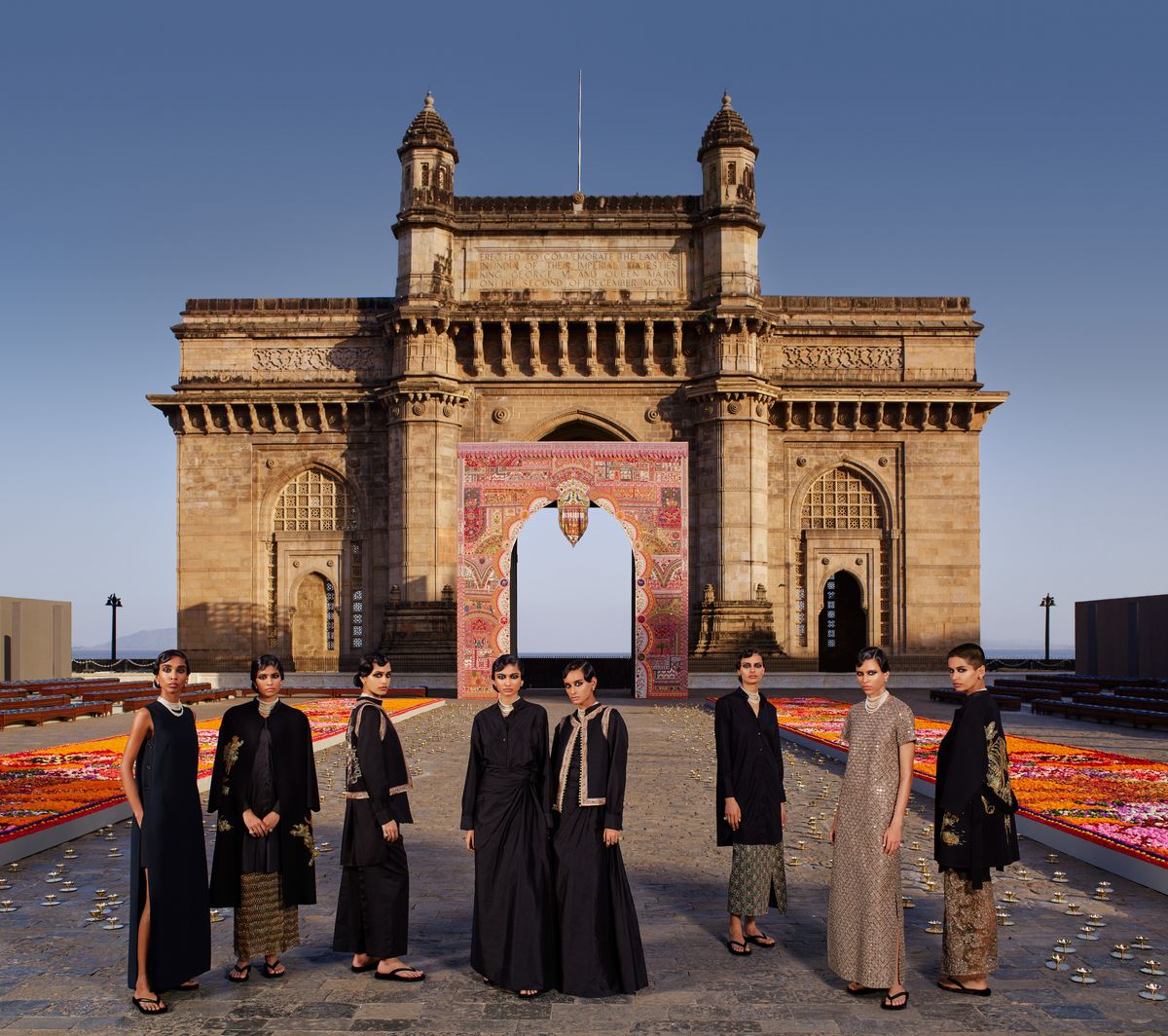Indian fashion thrives on artistic muses and meticulous craftsmanship that has inspired designers and fashion icons forever. Thanks to our decadent past and rich heritage of textile art, the source of design and inspiration for timeless creations never ceases to end for designers and brands that are always on the lookout for something innovative to add to their collections. From the intricate Tanjore, Madhubani, Kantha, Warli and Pattachitra artworks to the handmade kalamkari, chikankari, booti work, mirror work and fine metallic art of zardozi and zari – there’s no dearth of specialized textile artworks that can turn an ordinary garment into a couture piece. This season, influenced by the vibrant and elusive Indian crafts, local and international designers pay an ode through their collections.
Global appeal:
The first big sartorial story that comes to mind is the iconic Dior pre-fall 23 collection that was showcased in Mumbai at the Gateway of India in March this year. Dior’s Maria Grazia Chiuri presented a spectacular runway show to highlight the traditional Indian craftsmanship and the master artisans of the city’s famous Chanakya Ateliers with whom Chiuri has worked for over two decades. In an interview, she mentioned, “I personally wanted to celebrate and showcase the incredible knowledge India offers to the international world of fashion in the field of embroidery and the commitment of Chanakya’s founders to preserving India’s history and culture.” Using some of the finest fabrics and materials including metallic threads and glittering floral appliqués, the brand showcased an enormous collection inspired by all-things-Indian and shining the spotlight on the artisans. Looking at the global success of the show, Dior has now launched an exclusive Rani Pink bag with Indian motifs and designs for the Indian market and picked Ananya Panday for the promotional campaigns across digital platforms.
Indian influence:
The next big event that elevated India’s spot in the global luxury and fashion market was the opening of the Nita Mukesh Ambani Cultural Centre (NMACC) in Mumbai. The first-of-its-kind, multi-disciplinary cultural space saw a three-day long celebration of high-fashion and arts with international and Indian celebrities in attendance. While the hostess Nita Ambani was seen in some of the finest Indian designs by Indian designers like Abu Jani Sandeep Khosla, fashion icons like Gigi Hadid, Natasha Poonawala, Sonam Kapoor and others were also spotted in spectacular saris and lehengas that were high on Indian crafts. Model Gigi Hadid set the gold standard in a Kamasutra-inspired, South Indian temple jewellery cropped sleeve jacket blouse edged with bold tassels paired with a slim chikankari skirt and chikan sari drape by AJSK. The chikan work on her outfit was hand-embroidered by female artisans at Abu Jani Sandeep Khosla atelier in Lucknow, Uttar Pradesh. Whereas, Sonam Kapoor Ahuja donned a AJSK gajji silk lehenga that was hand embroidered with panels in zardozi, resham, vasli , marodi and tikki in a multitude of floral and Moghul motifs and paired with a vasli and Swarovski corset.
Innovation and reimagination:
For Indian designers and artisans, the challenge to reinvent and reimage the past perfect designs for a new age consumer is not just a daunting task but also requires the sensitivity to depict it without distortion. The timeless paisley or butta motif, which frequently appears on shirts, blouses, tunics, jackets, waistcoats, dresses, skirts, salwar kameez, kurtas, and even saris, is one of the most celebrated designs that never disappoint. Similarly, the rich textile and handloom art of Banarasi, Paithani, Patolas, Ikat and block printing is often seen on traditional attires, dupattas, shawls paired with unique patch work, Shisha or Abla embroideries. For high-end couture line, a lot of Indian designers frequently use techniques like looping, layering, applique, ribbon work, stuffing, beads, sequins, chording, crystal work and bead work to create head-turner ensembles for their clients.
Modern interpretation:
To celebrate the real essence of Indian craftsmanship, designers like Gautam Gupta of the fashion label Asha Gautam, has dedicated an entire Bridal collection to rich crafts and traditional textiles depicting the eternal love story of Radha-Krishna. The collection titled ‘Virndavan’ is a mixed bag of vibrant appliqué, rich embroideries, Nib Painting, Bandhani and Chikankari work. The designer has used weaves from Kota Dori, Real Banarasi Zari, and Paithani, paired with techniques like Knot Embroidery, Dabka, Kasab, Kashmiri Ari, Salma, Kora, Resham, Farsi Jaal, Zardosi, Dori, sequins and pearls, among others to highlight the Indian heritage in his creations.
On the other hand, designers like Rahul Mishra and Shilpi Gupta master the art of 3D embroidery and textured floral details on the garments using intricate embroideries and thread work with experimental and innovative details on bridal lehengas, saris, and gowns. This season, 3D embroidery is being used by many designers to create impactful designs on high fashion ensembles. The effect also magnifies elements of the motif-based design, making it more eye-catching and unique. At Indian label House of Surya, Indian crafts and surface textures bloom on the couture garments along with fabric applique work, embroidery applique work, 3D embellishments, quilting, cording and hand embroidery. And, for Kashimiri designer Sadaf Syed, founder of the label Maizah by Hands of Gold, the delicate threadwork and Kashmiri Aari with fine embellishments on silk kurtas and kaftans gives a perfect finish to the indigenous crafts story.

